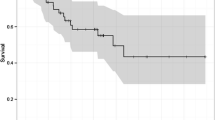Abstract
Background
Esophageal squamous cell carcinoma (ESCC) is a malignant tumor with a high incidence of lymph node metastasis. This study was undertaken to investigate the expression of CCR7 and VEGF-C in pN0 ESCC and its relationship with lymphatic metastatic recurrence.
Methods
The expression of CCR7 and VEGF-C was examined by RT-PCR and immunohistochemistry. The recurrence rates were calculated by the Kaplan–Meier method and their difference was determined by log rank analysis. Cox regression analysis was performed to determine the independent risk factors.
Results
In 99 patients, CCR7 mRNA expression was observed in 42 patients with a 3 year recurrence rate of 57.1 %; VEGF-C mRNA expression was observed in 52 patients with a 3 year recurrence rate of 53.8 %; and coexpression of CCR7 mRNA and VEGF-C mRNA was observed in 22 patients with a 3 year recurrencrate of 63.6 %. Neither CCR7 mRNA nor VEGF-C mRNA expression was observed in 27 patients with a 3 year recurrence rate of 22.2 %. The recurrence rates of patients with positive expression of CCR7 mRNA and/or VEGF-C mRNA were significantly higher than in patients without expression of both CCR7 mRNA and VEGF-C mRNA. We achieved better concordance between RT-PCR and immunohistochemistry detection of both markers. The Cox regression analysis showed tumor T classification, positive expression of CCR7/VEGF-C mRNA, and positive expression of CCR7/VEGF-C protein in tumor tissues to be independent risk factors for 3 year recurrence.
Conclusions
Patients with positive expression of CCR7 and/or VEGF-C have a higher recurrence rate than patients without expression of both CCR7 and VEGF-C. CCR7 and VEGF-C may become molecular indicators of disease in patients vulnerable to lymphatic metastatic recurrence.






Similar content being viewed by others
References
Ferlay J, Shin HR, Bray F, Forman D, Mathers C, Parkin DM. Estimates of worldwide burden of cancer in 2008. Int J Cancer. 2010;127:2893–917.
Hiyama T, Yoshihara M, Tanaka S, Chayama K. Genetic polymorphisms and esophageal cancer risk. Int J Cancer. 2007;121:1643–58.
Dresner SM, Griffin SM. Pattern of recurrence following radical oesophagectomy with two-field lymphadenectomy. Br J Surg. 2000;87:1426–33.
Mariette C, Piessen G,Triboulet JP. Therapeutic strategies in oesophageal carcinoma: role of surgery and other modalities. Lancet Oncol. 2007;8:545–53.
Hulscher JB, van Sandick JW, Tijssen JG, Obertop H, van Lanschot JJ. The recurrence pattern of esophageal carcinoma after transhiatal resection. J Am Coll Surg. 2000;191:143–8.
Li H. Modern esophageal surgery. Beijing: People’s Military Medical Press, 2004. p. 11–26.
Chen G, Wang Z, Liu XY, Liu FY. Recurrence pattern of squamous cell carcinoma in the middle thoracic esophagus after modified Ivor-Lewis esophagectomy. World J Surg. 2007;31:1107–14.
Law S, Wong J. Two-field dissection is enough for esophageal cancer. Dis Esophagus. 2001;14:98–103.
Kunisaki C, Makino H, Takagawa R, et al. Surgical outcomes in esophageal cancer patients with tumor recurrence after curative esophagectomy. J Gastrointest Surg. 2008;12:802–10.
Sun ZG, Wang Z, Liu XY, Liu FY. Mucin 1 and vascular endothelial growth factor C expression correlates with lymph node metastatic recurrence in patients with N0 esophageal cancer after Ivor-Lewis esophagectomy. World J Surg. 2011;35:70–7.
Möbius C, Freire J, Becker I, et al. VEGF-C expression in squamous cell carcinoma and adenocarcinoma of the esophagus. World J Surg. 2007;31:1768–74.
Ding Y, Shimada Y, Maeda M, et al. Association of CC chemokine receptor 7 with lymph node metastasis of esophageal squamous cell carcinoma. Clin Cancer Res. 2003;9:3406–12.
Gou HF, Chen XC, Zhu J, et al. Expressions of COX-2 and VEGF-C in gastric cancer: correlations with lymphangiogenesis and prognostic implications. J Exp Clin Cancer Res. 2011;30:14.
Wang Z, Liu XY, Liu FY, Chen JH. A study of correlation between early postoperative relapse with lymph node micrometastasis in patients with N0 esophageal cancer. Chin J Surg. 2004;42:68–71.
Nakagawa S, Kanda T, Kosugi S, Ohashi M, Suzuki T, Hatakeyama K. Recurrence pattern of squamous cell carcinoma of the thoracic esophagus after extended radical esophagectomy with three-field lymphadenectomy. J Am Coll Surg. 2004;198:205–11.
Kitadai Y, Amioka T, Haruma K, et al. Clinicopathological significance of vascular endothelial growth factor (VEGF)-C in human esophageal squamous cell carcinomas. Int J Cancer. 2001;93:662–6.
Noguchi T, Takeno S, Shibata T, Uchida Y, Yokoyama S, Müller W. VEGF-C expression correlates with histological differentiation and metastasis in squamous cell carcinoma of the esophagus. Oncol Rep. 2002;9:995–9.
Chen G. Advance on chemokines in organ-specific metastasis of non–small cell lung cancer. Chin J Lung Cancer. 2009;12:1110–4.
Ishida K, Iwahashi M, Nakamori M, et al. High CCR7 mRNA expression of cancer cells is associated with lymph node involvement in patients with esophageal squamous cell carcinoma. Int J Oncol. 2009;34:915–22.
Zhang MY, Wang Z, Liu XY, Chen G, Liu FY. The local control of radiotherapy following Ivor-Lewts esophagectomy in the patients with stage IIA middle-third thoracic esophageal cancer. Chin J Surg. 2008;46:1048–50.
Acknowledgment
The authors extend their appreciation to the Department of Thoracic Surgery, Pathology Department, Central Laboratory of the provincial hospital affiliated with Shandong University, Shanghai Sangon Biological Engineering Technology Services Limited Corporation, for their help in the design of the study and experimental techniques.
Author information
Authors and Affiliations
Corresponding author
Rights and permissions
About this article
Cite this article
Song, Y., Wang, Z., Liu, X. et al. CCR7 and VEGF-C: Molecular Indicator of Lymphatic Metastatic Recurrence in pN0 Esophageal Squamous Cell Carcinoma after Ivor-Lewis Esophagectomy?. Ann Surg Oncol 19, 3606–3612 (2012). https://doi.org/10.1245/s10434-012-2419-y
Received:
Published:
Issue Date:
DOI: https://doi.org/10.1245/s10434-012-2419-y




